Lindsey Lyons
Lindsey Lyons hails from the swamps and humidity of Sarasota, Florida, but has spent the last decade in California. Based in Los Angeles, she mainly identifies as a painter, but has felt a surge of sculptural inspiration take charge in her work. I met with her on a bright afternoon to discuss her exhibition at Adobe Books in San Francisco (on view through November 28
Words and studio images by Inga Schunn.













When were you first drawn to painting?
I would say that as a kid I was a left-handed perfectionist, so right away I had crayons in my left hand painstakingly coloring in my coloring books. Everyone around me who wasn’t an artist thought of it as a talent, so I was always encouraged. I internalized it and always picked the art classes in school. Everything was always an assignment though, and it wasn’t until college that I really got pushed to start experimenting with my own ideas. That’s when I realized I really enjoyed processed based work and not painting photorealistically or figuratively. So I think I’ve always really liked art and painting, but it took a while for me to embrace the fact that I like making abstract work, and that that is a significant thing in the art world. So it’s been an evolved process.
What inspires your work?
I like looking at the ground and noticing all the weird little details. It’s both urban like shattered glass and bits and pieces of plastics, but I’m also thinking about things like deep time...thinking about way back, way underground, the layers of the ground. Especially being in California, we’re all very aware of tectonic plates, all of this activity underground.
You must be inspired by a lot of Geology then, right? Could you tell me what you mean by the term deep time?
Yeah! So, deep time is the concept of geologic time. We are this tiny blip in the grand scheme of the universe. I want people to look at my work and say, “Wait, am I looking at 2016 or am I thinking about what it would be like to live on the planet before everything was totally formed?”
Do you think of painters as philosophers?
I think most of my ideas are so visual. I want people to have questions by looking at the work, and I want them to come up with their own philosophies. When I think about viewers I really do want people to slow down and look and notice details.
Do you reference a lot of books when you’re thinking about these things, or do you go back to experiences that you’ve had?
I think for some of it I go back to experience. I like getting to the water, the beach, out to rocky cliffs, the desert...really charged landscapes. Charged in the sense that they’re really vast: you can see everything because it’s not like a city street, dotted with buildings. I feel like there aren’t many places like Joshua Tree. You can just pick up on this sort of energy. I think there’s an intensity in the fact that you can’t just wing it out there, you have to be prepared. A big part of my work is that it’s very process based. I’m constantly experimenting. I don’t really ever go into a work with a number by number blueprint of what I’m going to make. You might say that my preparation for a piece is, if I’m just not feeling it, to get out to the landscape, to a rock, to the ocean, to tap back into what I make. So then when I come into the studio I have this blank canvas waiting for me, but I have a lot of these ideas and collected objects and slivers of plastic. Even debris and leftovers of other works that I’ve made. I have a whole box of things that other people would think is trash, but I’m like, “No, this broken mirror is perfect, look at these nice shards!” (laughs)
So, how do you source your materials? Do you just kind of let things come into your life?
I do go to thrift stores. Sometimes there are objects there that speak to me, but I also will pick things up that interest me. I try not to question too much what I might use them for. If a thing resonates I will grab it and bring it back to the studio and it will kind of find its way to where it needs to go. Some of these collected pieces may just be influences, other pieces actually physically get inserted into the work. I would say I’m a water-based artist. I use a lot of it in my work with acrylic paint, so I’ll sometimes put rocks or other collected objects onto the surface of a painting or something so that as the pigment is drying around it, it will leave these traces. So even if they’re not physically stuck on – I don’t identify as a collage artist – they’re there the way that my hand as an artist is there. Actually, I am sometimes leaving fingerprints in the paint, but I’m not leaving my hand in the painting.
I feel like it would be pretty hard for a painter not to have their hand in their work.
Exactly! I try not to overthink anything too much, but I do tend to make work fairly quickly. If I overwork something it usually doesn’t work out, so I make a lot of things and then step back and see what works together.
Do you think about the photographic process at all?
Yes! I don’t identify as a photographer, but I do paint on photographic paper. I also have this series called “Flash” which were all photographed outdoors at night, lit with nothing but a flashlight. I’ve never printed them. Inserting them into the current work hasn’t been a thought; I still kind of identify as more of an abstract artist, but I really love looking at photographs. I think half of that enjoyment comes from the reflective qualities. Whether the print is on a shiny piece of paper or behind a glass frame, I really like that as you walk about the piece it changes because the light is bouncing off of it. I love shiny stuff (laughs) but let’s not confuse shiny with glitzy. I’ve always gravitated towards plastics. In graduate school my professors and I talked about it being an almost shrouded, protective quality about the material, and if I’m talking about the work, acknowledging the past, or giving more meaning to fragmented or discarded things, the plastic is protecting and refreshing the work. So, I started experimenting with ways to incorporate it into the paintings and then even painting onto clay blocks, still wrapped in their plastic.
Yes, I love those, they’re interesting. They show how you’re definitely interested in this act of shrouding, and how painting can kind of cover things up while keeping something alive, but also create something new, which is basically what photographs are said to do!
Totally!
Tell me a little bit about your show at Adobe Books.
Well, I’m in a group show opening in November called "Traces" at this great space, Adobe Books Backroom Gallery that’s part of Adobe Books. It’s kind of a mainstay in the Mission district of San Francisco. The show is all about leftovers and traces of things.





